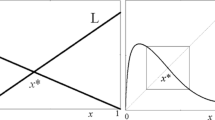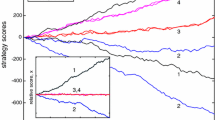Abstract
The minority game (MG) is used as a source of information to design complex networks where the nodes represent the playing agents. Differently from classical MG consisting of independent agents, the current model rules that connections between nodes are dynamically inserted or removed from the network according to the most recent game outputs. This way, preferential attachment based on the concept of social distance is controlled by the agents wealth. The time evolution of the network topology, quantitatively measured by usual parameters, is characterized by a transient phase followed by a steady state, where the network properties remain constant. Changes in the local landscapes around individual nodes depend on the parameters used to control network links. If agents are allowed to access the strategies of their network neighbors, a feedback effect on the network structure and game outputs is observed. Such effect, known as herding behavior, considerably changes the dependence of volatility σ on memory size: it is shown that the absolute value of σ as well as the corresponding value of memory size depend both on the network topology and on the way along which the agents make their playing decisions in each game round.
Similar content being viewed by others
References
B. LeBaron, J. Econ. Dyn. Control 24, 679 (2000)
N.F. Johnson, P. Jefferies, P.M. Hui, Financial market complexity (Oxford University Press, Oxford, 2003)
D. Challet, Y.C. Zhang, Physica A 246, 407 (1997)
W.B. Arthur, Am. Econ. Rev. 84, 406 (1994)
A.C.C. Coolen, The mathematical theory of minority games (Oxford University Press, Oxford, 2005)
D. Challet, M. Marsili, Y.C. Zhang, Minority games (Oxford University Press, Oxford, 2005)
R. Savit, R. Manuca, R. Riolo, Phys. Rev. Lett. 82, 2203 (1999)
T. Kalinowski, H.-J. Schulz, M. Briese, Physica A 277, 502 (2000)
S. Moelbert, P.D.L. Rios, Physica A 303, 217 (2002)
A. Galstyan, K. Lerman, Phys. Rev. E 66, 015103 (2002)
H.J. Quan, B.H. Wang, P.M. Hui et al., Physica A 321, 300 (2003)
H.F. Chau, F.K. Chow, K.H. Ho, Physica A 332, 483 (2004)
Y. Li, R. Savit, Physica A 335, 217 (2004)
E. Burgos, H. Ceva, R.P.J. Perazzo, Physica A 337, 635 (2004)
I. Caridi, H. Ceva, Physica A 339, 574 (2004)
L. Shang, X.F. Wang, Physica A 361, 643 (2006)
M. Kirley, Physica A 365, 521 (2005)
H. Lavicka, F. Slanina, Eur. Phys. J. B 56, 53 (2007)
D.O. Cajueiro, R.S. DeCamargo, Phys. Lett. A 355, 280 (2006)
D.O. Cajueiro, Phys. Rev. E 72, 047104 (2005)
M.O. Jackson, B.W. Rogers, J. Eur. Econ. Assoc. 3, 617 (2005)
R. Carvalho, G. Iori, Phys. Rev. E 78, 016110 (2008)
P. Erdós, A. Rényi, Bulletin of the International Statistical Institute 38, 343 (1960)
D.J. Watts, S.H. Strogatz, Nature 393, 440 (1998)
D.J. Watts, Small worlds: the dynamics of networks between order and randomness (Princeton University Press, Princeton, 1999)
A.L. Barabasi, R. Albert, Science 286, 509 (1999)
C. Castellano, S. Fortunato, V. Loreto, Rev. Mod. Phys. 81, 591 (2009)
M.L. Lyra, U.M.S. Costa, R.N.C. Filho et al., Europhys. Lett. 62, 131 (2003)
A.A. Moreira, D.R. Paula, R.N. Costa et al., Phys. Rev. E 73, 065101 (2006)
P.G. Lind, L.R.D. Silva, J.S.A. Jr. et al., Phys. Rev. E 76, 036117 (2007)
A.A. Moreira, A. Mathur, D. Diermeier et al., Proceedings of the National Academy of Sciences of the United States of America 101, 12085 (2004)
B.A. Mello, L.H. Batistuta, R. Boueri et al., Phys. Lett. A 28, 126 (2009)
V. Schwammle, M.C. Gonzalez, A.A. Moreira et al., Phys. Rev. E 75, 066108 (2007)
M. Anghel, Z. Toroczkai, K.E. Bassler et al., Phys. Rev. Lett. 92, 058701 (2004)
M. Boguña, R. Pastor-Satorras, A. Diaz-Guilera et al., Phys. Rev. E 70, 056122 (2004)
G.C.M.A. Ehrhardt, M. Marsili, F. Vega-Redondo, Phys. Rev. E 74, 036106 (2006)
A. Grabowski, R.A. Kosinki, Phys. Rev. E 73, 016135 (2006)
E.M. Jin, M. Girvan, M.E.J. Newman, Phys. Rev. E 64, 046132 (2001)
D.J.B. Soares, C. Tsallis, A.M. Mariz et al., Europhys. Lett. 70, 70 (2005)
L.H. Wong, P. Pattison, G. Robins, Physica A 360, 99 (2006)
K. Kosmidis, S. Havlin, A. Bunde, Europhys. Lett. 82, 48005 (2008)
R. Lambiotte, V.D. Blondel, C. De-Kerchove et al., Physica A 387, 5317 (2008)
J. Wakeling, P. Bak, Phys. Rev. E 64, 051920 (2001)
B.A. Mello, D.O. Cajueiro, Physica A 387, 557 (2008)
D. Challet, M. Marsili, G. Ottino, Physica A 332, 469 (2004)
C.P. Chamley, Rational herds: economic models of social learning (Cambridge University Press, Cambridge, 2004)
C. Song, S. Havlin, H.A. Makse, Nature 433, 392 (2005)
M.E.J. Newman, Phys. Rev. Lett. 89, 208701 (2002)
M.E.J. Newman, J. Park, Phys. Rev. E 68, 036122 (2003)
R. Toivonen, J.P. Onella, J. Saramaki, Physica A 371, 851 (2006)
Author information
Authors and Affiliations
Corresponding author
Rights and permissions
About this article
Cite this article
Mello, B., Souza, V., Cajueiro, D. et al. Network evolution based on minority game with herding behavior. Eur. Phys. J. B 76, 147–156 (2010). https://doi.org/10.1140/epjb/e2010-00179-1
Received:
Revised:
Published:
Issue Date:
DOI: https://doi.org/10.1140/epjb/e2010-00179-1




